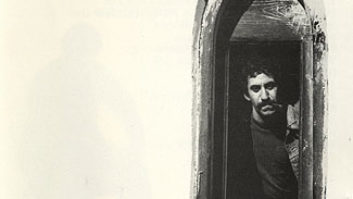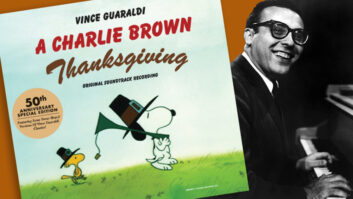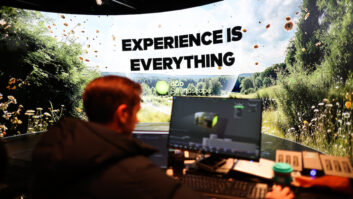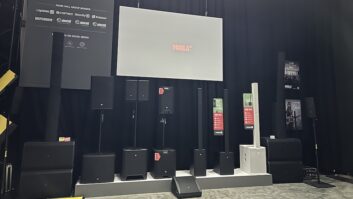
Time was when a jazz performance required little in the way of equipment: A couple of mics, a couple of wedges, a little combo mixer, and off you went. It’s not so simple now, even for a classic jazz outfit like the Norman Brown Group. Brown, a multi-award-winning master guitarist who’s been compared to George Benson and Wes Montgomery, obviously sounds great solo. Sometimes, he travels solo, but usually, he performs with his five-piece band. A prolific performer, Brown put in close to 90 dates in 2002. He was out supporting two Warner Bros. CDs: Just Chillin‘, his latest chart-topping solo effort, which is nominated for a 2003 Grammy™ in the Best Pop Instrumental category, and Groovin‘, from bwb, a jazz supergroup comprising Brown, saxophonist Kirk Whalum and trumpeter Rick Braun. As with many artists, the equipment Brown’s group carries varies according to the gig, or group of gigs, scheduled on any given run. Often, except for guitars and a few other essentials, the band relies on the fulfillment of their tech rider for backline instruments, and house and monitor systems. Recently, Brown and his FOH mixer/production manager Stanley B (an accomplished pianist and composer, who released his own solo album All for Love in 2002) have also been taking a Digital Performer-based system on the road to record the shows.
“I’ve been fortunate to have the same core band since I started recording in ’91,” says Brown, who was born in Kansas City and now lives in L.A. “Alonzo ‘Scooter’ Powell on drums, James Manning on bass, Brian Simpson on keyboards [Kurzweil PC88 controller/Roland synthesizers], and Gail Johnson, my musical director, on keys [Yamaha Motif/Roland synthesizers] and background vocals. Sometimes, we take out other background vocalists and horns, and we’ve experimented with using recorded backgrounds on ADAT, DAT and MiniDisc; but, mostly, Gail and I cover all of the vocals.”
PACK IT UP
Brown travels with two guitars: an Ibanez George Benson model in checked baggage and a smaller D’Angelico carried onboard. Interestingly, he notes that recent changes in security regulations have actually made it easier to stash his axe in an overhead compartment. “I have no problems,” he says. “They’re strict on weight, size and the number of pieces per person, but after that, they’re pretty cool. There seemed to be a learning curve after 9/11, but airline personnel are actually much more helpful now than they were before.”
When possible, Brown carries his own amps, a Polytone, “the one with modified ‘mini brute,’” he comments. “It’s an experimental model they tried, with two speakers angled in toward each other. I use that and also the Tophat, which is a custom tube amp that’s much warmer.”
When he can’t bring his amplification, Brown requests either a Fender Blues DeVille Tweed or the more commonly available Fender Twin ’65 reissue. “We tend to be able to get the ’65 reissue everywhere,” he says, “and most of them are in fairly good shape. I mean, they’ve been beat up, but they can take it! That’s probably why they’re so available.”
Always with him is his rack that contains a Shure wireless system and a Line 6 POD Pro, which he calls the “brain for everything.” The only discrete effect carried is an original Crybaby wah-wah pedal.
“I take the preamp stereo outs [of the POD], which are pretty clean, into the house,” explains B. “And I use an SM57 on the Fenders, which really captures them well. Most of the time, it sounds great with good presence, so I don’t have to equalize, which makes me very happy. Of course, it depends on the shape of the house and how many people are in it. There are situations where I have to roll off a little of the low frequencies, or where the reverb is too much or not enough. Also, usually on the mics, I have to do some hum eliminating using a Waves guitar hum eliminator. It works well, but, of course, it’s better not to use it. It does affect the sound, and then you have to do other things to bring back what you lost — usually the crisp highs. You also have to be careful not to lose the part of the noise that sounds good.
“If it’s not a little noisy, it’s not my sound,” adds Brown. “It’s a jazz guitar, but it’s got some edge. On my CDs, I record with a vintage [Gibson] L5 that has a really clean, jazzy tone, kind of like a George Benson sound. But live, my Jimi Hendrix influence comes out,” he says with a laugh, “and it’s added to that tone. It’s still got that round fullness, but it’s a little edgier. A little noise definitely sounds good.”
POWERING THE HOUSE
In the rider, B specifies Yamaha as his first choice for consoles: a 40-channel M3000A for FOH and a 32×12 for monitors. “As a piano player myself, working with different pianos,” he notes, “I’ve seen that Yamaha is always very consistent. The same is true of their mixers. They use very good components, very good electronics and the sound is always the same, unlike with some other manufacturers. We like to have 56 inputs, and we need at least 40; especially since we’ve started recording the shows, we’re using a lot more inputs, like for top and bottom snare, direct and miked bass, etc., so that we have more options for blending. It’s helpful for the sound of the show, and it’s also helpful to the mixing process afterward.”
Other gear requested for FOH includes either two 2-channel, ⅓-octave Ashly GQ231 EQs or Klark Teknik EQs, along with eight dbx 160 compressor/ limiters and four BSS noise gates. Effects are either Lexicon PCM 81s, Yamaha SPX90s or Rev 5s.
Drummer Powell also favors Yamaha for his kit, with Remo drum heads, Emperor tops and Diplomat bottoms, and a Power-stroke on kick. B uses Shure SM57s on all of the drums, except for the kick, which gets a Shure PG52, and overheads, which usually get a pair of SM81s. “It’s very important to capture the overhead sound and the overall vibe onstage properly,” he notes. “It brings the entire sound another step up, and it becomes more alive. Sometimes for recording, I hang an AKG 414TLII in a figure-8 pattern to capture the overheads, which provides more volume to the overall sound. With proper blending, you can get amazing results in some venues.”
The band listens on wedge monitors, but Brown uses a Shure PSM600 ear monitor in one ear. “Just the left,” he says. “I love that the in-ears allow me to hear the same mix wherever I go on the stage, but I also need to feel the air moving.”
Brown’s own vocal mic, a Shure Beta 58 wireless, is one of the essential items that always travels with the band. “That’s the mic I love,” he says. “It’s got the warmth, and you don’t have to add a lot of EQ. If I try to use something else, I really notice the difference. I have to work a lot harder to get it to sound right. I’ll say it for the record, I love Shure mics.”
In anticipation of assembling a live album, B has started recording shows. He uses the same Digital Performer setup on the road that he helped Brown assemble for his home studio. “We use a laptop G4, with a gig of RAM,” he says. “And we record via two or three MOTU 896s and one 828 to an external 120-gig LaCie FireWire drive. The laptop only has one output, so instead of using a FireWire hub, which causes you to lose some of the bandwidth on the FireWire interface, we just take one FireWire drive, go to that first and chain the other guys together to get 24 or 32 channels. The 828 is the only one that can’t be chained, so we make that last. It works really well.”
Next on B’s list is to put together virtual synths and a unified database with all of the necessary sample libraries for the road. That would eliminate the need for rentals of the multiple keyboards the band requires, and also give him more control over individual program levels and DSP processing. “It’s a small band, but there’s a lot going on,” he admits. “Norman likes to re-create live what he does on the CDs, so there are strings, horns, piano and other parts. There’s a lot of keyboard layering, and the bass player adds a DX7 bass on some songs. When we get those parts in the computer, it will be a lot easier to balance.”
With another album in the works and a lengthy roster of gigs in place for 2003, there’ll be plenty of opportunity for further innovation. It doesn’t look like there’s any boredom scheduled in the near future for either Brown or Stanley B, which is the just the way they like it. Check www.NormanBrown.com for tour dates.

Portraits of Norman Brown onstage, by Steve Jennings







